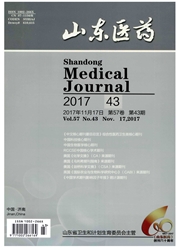

 中文摘要:
中文摘要:
目的探讨JNK/ATF-2信号通路在。肾脏缺血再灌注损伤(IR)中的作用。方法将60只雄性Wistar大鼠随机分为假手术组(对照组)和缺血再灌注组(IR组),每组30只。IR组制备IR模型。各组分别于再灌注0、10、30min及1、24h各处死6只大鼠,取其肾组织,采用免疫组化及RT—PCR法检测不同时间点肾小管上皮细胞JNK、ATF-2磷酸化蛋白及mRNA表达水平。结果IR组JNK、ATF-2mRNA及蛋白表达早期即有增加,再灌注30min出现高峰,再灌注1h表达略减弱,24h仍有高表达,与假手术组比较,差异均有统计学意义。结论肾脏缺血再灌注后JNK/ATF-2信号通路在肾小管上皮细胞表达明显上调,抑制其表达可减轻肾脏损伤。
 英文摘要:
英文摘要:
Objective To investigate the expression of c-Jun amino-terminal kinase (JNK)/ATF-2 signaling pathway on renal ischemia reperfusion injury in rat. Methods A total of 60 male Wistar rats were randomly divided into sham group (sham group, n = 30) and ischemia-reperfusion group (IR group, n = 30). Rats were sacrificed at different times (0 min, 10 min, 30 min, 1 h, 24 h) after reperfusion. Expression of JNK, ATF-2 were analyzed by methods of immuno- histochemistry and RT-PCR. Results In IR group, the expression of JNK, ATF-2 increased at early time, peaked at 30 min, and last for 24 h. Compared with sham group, the differences were significant. Conclusion JNK/ATF-2 signaling pathway can be activated in renal tubular epithelial cells after renal ischemia reperfusion.
 同期刊论文项目
同期刊论文项目
 同项目期刊论文
同项目期刊论文
 Renal amyloidosis and hepatitis B virus-associated glomerulonephritis in a patient with nephrotic sy
Renal amyloidosis and hepatitis B virus-associated glomerulonephritis in a patient with nephrotic sy Green Tea Polyphenol (?)-Epigallocatechin-3-Gallate Restores Nrf2 Activity and Ameliorates Crescenti
Green Tea Polyphenol (?)-Epigallocatechin-3-Gallate Restores Nrf2 Activity and Ameliorates Crescenti Mutation analysis and audiologic assessment in six chinese children with primary distal renal tubula
Mutation analysis and audiologic assessment in six chinese children with primary distal renal tubula 期刊信息
期刊信息
